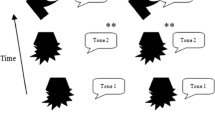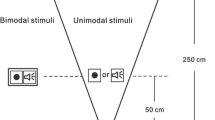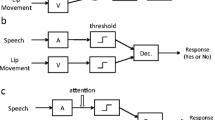Abstract
When presented with auditory, visual, or bimodal audiovisual stimuli in a speeded detection/discrimination task, participants fail to respond to the auditory component of the bimodal targets significantly more often than they fail to respond to the visual component. Signal detection theory (SDT) was used to explore the contributions of perceptual (sensitivity shifts) and decisional (shifts in response criteria) factors to this effect, known as the Colavita visual dominance effect. Participants performed a version of the Colavita task that had been modified to allow for SDT analyses. The participants had to detect auditory and visual targets (presented unimodally or bimodally) at their individually determined 75% detection thresholds. The results showed a significant decrease in participants’ sensitivity to auditory stimuli when presented concurrently with visual stimuli (in the absence of any significant change in their response criterion), suggesting that Colavita visual dominance does not simply reflect a decisional effect, but can be explained, at least in part, as a truly perceptual phenomenon. The decrease in sensitivity (to auditory stimuli) may be attributable to the exogenous capture of participants’ attention by the visual component of the bimodal target, thus leaving fewer attentional resources for the processing of the auditory stimulus. The reduction in auditory sensitivity reported here may be considered an example of crossmodal masking.

Similar content being viewed by others
References
Aschersleben G, Bachmann T, Műssler J (eds) (1999) Cognitive contributions to the perception of spatial and temporal events (Advances in Psychology, 129). Elsevier Science B.V/North-Holland, Amsterdam
Bartolomeo P, Chokron S (2002) Orienting of attention in left unilateral neglect. Neurosci Biobehav Rev 26:217–234
Bartolomeo P, Siéroff E, Decaix C, Chokron S (2001) Modulating the attentional bias in unilateral neglect: the effects of the strategic set. Exp Brain Res 137:424–431
Bender MB (1952) Disorders in perception. Charles Thomas, Springfield
Bertelson P, de Gelder B (2004) The psychology of multimodal perception. In: Spence C, Driver J (eds) Crossmodal space and crossmodal attention. Oxford University Press, Oxford, pp 141–177
Bonneh YS, Belmonte MK, Pei F, Iversen PE, Kenet T, Akshoomoff N, Adini Y, Simon HJ, Moore CI, Houde JF, Merzenich MM (2008) Cross-modal extinction in a boy with severely autistic behavior and high verbal intelligence. Cogn Neuropsychol 25:635–652
Briand KA, Klein RM (1987) Is Posner’s “beam” the same as Triesman's “glue”? On the relation between visual orienting and feature integration theory. J Exp Psychol Hum Percept Perform 13:228–241
Calvert GA, Spence C, Stein BE (eds) (2004) The handbook of multisensory processes. MIT Press, Cambridge
Colavita FB (1974) Human sensory dominance. Percept Psychophys 16:409–412
Colavita FB (1982) Visual dominance and attention in space. Bull Psychon Soc 19:261–262
Colavita FB, Weisberg D (1979) A further investigation of visual dominance. Percept Psychophys 25:345–347
Colavita FB, Tomko R, Weisberg D (1976) Visual prepotency and eye orientation. Bull Psychon Soc 8:25–26
Cooper R (1998) Visual dominance and the control of action. In: Gernsbacher MA, Derry SJ (eds) Proceedings of the 20th annual conference of the cognitive science society, pp 250–255
Cornsweet TN (1962) The staircase-method in psychophysics. Am J Psychol 75:485–491
Costantini M, Bueti D, Pazzaglia M, Aglioti SM (2007) Temporal dynamics of visuo-tactile extinction within and between hemispaces. Neuropsychology 21:242–250
Egeth HE, Sager LC (1977) On the locus of visual dominance. Percept Psychophys 22:77–86
Fagot C, Pashler H (1992) Making two responses to a single object: implications for the central attentional bottleneck. J Exp Psychol Hum Percept Perform 18:1058–1079
Gorea A, Sagi D (2000) Failure to handle more than one internal representation in visual detection tasks. Proc Natl Acad Sci USA 97:12380–12384
Gorea A, Sagi D (2002) Natural extinction: a criterion shift phenomenon. Vis Cogn 9:913–936
Green DM, Swets JA (1966) Signal detection theory and psychophysics. Wiley, New York
Hartcher-O’Brien J, Gallace A, Krings B, Koppen C, Spence C (2008) When vision ‘extinguishes’ touch in neurologically-normal people: extending the Colavita visual dominance effect. Exp Brain Res 186:643–658
Hawkins HJ, Hillyard SA, Luck SJ, Mouloua M, Downing CJ, Woodward DP (1990) Visual attention modulates signal detectability. J Exp Psychol Hum Percept Perform 16:802–811
Hecht D, Reiner M (2009) Sensory dominance in combinations of audio, visual and haptic stimuli. Exp Brain Res 193:307–314
Koppen C, Spence C (2007a) Seeing the light: exploring the Colavita visual dominance effect. Exp Brain Res 180:737–754
Koppen C, Spence C (2007b) Spatial coincidence modulates the Colavita visual dominance effect. Neurosci Lett 417:107–111
Koppen C, Spence C (2007c) Assessing the role of stimulus probability on the Colavita visual dominance effect. Neurosci Lett 418:266–271
Koppen C, Spence C (2007d) Audiovisual asynchrony modulates the Colavita visual dominance effect. Brain Res 1186:224–232
Koppen C, Alsius A, Spence C (2008) Semantic congruency and the Colavita visual dominance effect. Exp Brain Res 184:533–546
Lavie N (2005) Distracted and confused?: selective attention under load. Trends Cogn Sci 9:75–82
Logan GD (1992) Attention and preattention in theories of automaticity. Am J Psychol 105:317–339
Macmillan NA, Creelman CD (1991) Detection theory: a user’s guide. Cambridge University Press, Cambridge
Maravita A, Husain M, Clarke K, Driver J (2001) Reaching with a tool extends visual-tactile interactions into far space: evidence from cross-modal extinction. Neuropsychologia 39:580–585
Mattingley JB, Driver J, Beschin N, Robertson IH (1997) Attentional competition between modalities: extinction between touch and vision after right hemisphere damage. Neuropsychologia 35:867–880
Olson E, Stark M, Chatterjee A (2003) Evidence for a unimodal somatosensory attention system. Exp Brain Res 151:15–23
Posner MI, Nissen MJ, Klein RM (1976) Visual dominance: an information-processing account of its origins and significance. Psychol Rev 83:157–171
Quinlan P (2000) The “late” locus of visual dominance. Abst Psychon Soc 5:64
Ricci R, Chatterjee A (2004) Sensory and response contributions to visual awareness in extinction. Exp Brain Res 157:85–93
Rock I, Victor J (1964) Vision and touch: an experimentally created conflict between the two senses. Science 143:594–596
Sarri M, Blankenburg F, Driver J (2006) Neural correlates of crossmodal visual-tactile extinction and of tactile awareness revealed by fMRI in a right-hemisphere stroke patient. Neuropsychologia 44:2398–2410
Schneider W, Eschman A, Zuccolotto A (2002a) E-Prime user’s guide. Psychology Software Tools Inc, Pittsburgh
Schneider W, Eschman A, Zuccolotto A (2002b) E-Prime reference guide. Psychology Software Tools Inc, Pittsburgh
Shams L, Kamitani Y, Shimojo S (2000) What you see is what you hear: Sound induced visual flashing. Nature 408:788
Shapiro KL, Johnson TL (1987) Effects of arousal on attention to central and peripheral visual stimuli. Acta Psychol 66:157–172
Shapiro KL, Egerman B, Klein RM (1984) Effects of arousal on human visual dominance. Percept Psychophys 35:547–552
Sinnett S, Spence C, Soto-Faraco S (2007) Visual dominance and attention: the Colavita effect revisited. Percept Psychophys 69:673–686
Sinnett S, Soto-Faraco S, Spence C (2008) The co-occurrence of multisensory competition and facilitation. Acta Psychol 128:153–161
Spence C (2007) Making sense of touch: a multisensory approach to the perception of objects. In: Pye E (ed) The power of touch: handling objects in museums and heritage contexts. Left Coast Press, Walnut Creek, California, pp 45–61
Spence C (2009) Explaining the Colavita visual dominance effect. Prog Brain Res (in press)
Theeuwes J, Kramer AF, Atchley P (1999) Attentional effects on preattentive vision: spatial precues affect the detection of simple features. J Exp Psychol Hum Percept Perform 25:341–347
Treisman AM, Gelade G (1980) A feature-integration theory of attention. Cogn Psychol 12:97–136
Watkins S, Shams L, Tanaka S, Haynes J-D, Rees G (2006) Sound alters activity in human V1 in association with illusory visual perception. Neuroimage 31:1247–1256
Zahn TP, Pickar D, Haier RJ (1994) Effects of clozapine, fluphenazine, and placebo on reaction time measures of attention and sensory dominance in schizophrenia. Schizophr Res 13:133–144
Acknowledgments
C. K. was supported by a Departmental Studentship from the Department of Experimental Psychology, University of Oxford.
Author information
Authors and Affiliations
Corresponding author
Rights and permissions
About this article
Cite this article
Koppen, C., Levitan, C.A. & Spence, C. A signal detection study of the Colavita visual dominance effect. Exp Brain Res 196, 353–360 (2009). https://doi.org/10.1007/s00221-009-1853-y
Received:
Accepted:
Published:
Issue Date:
DOI: https://doi.org/10.1007/s00221-009-1853-y




